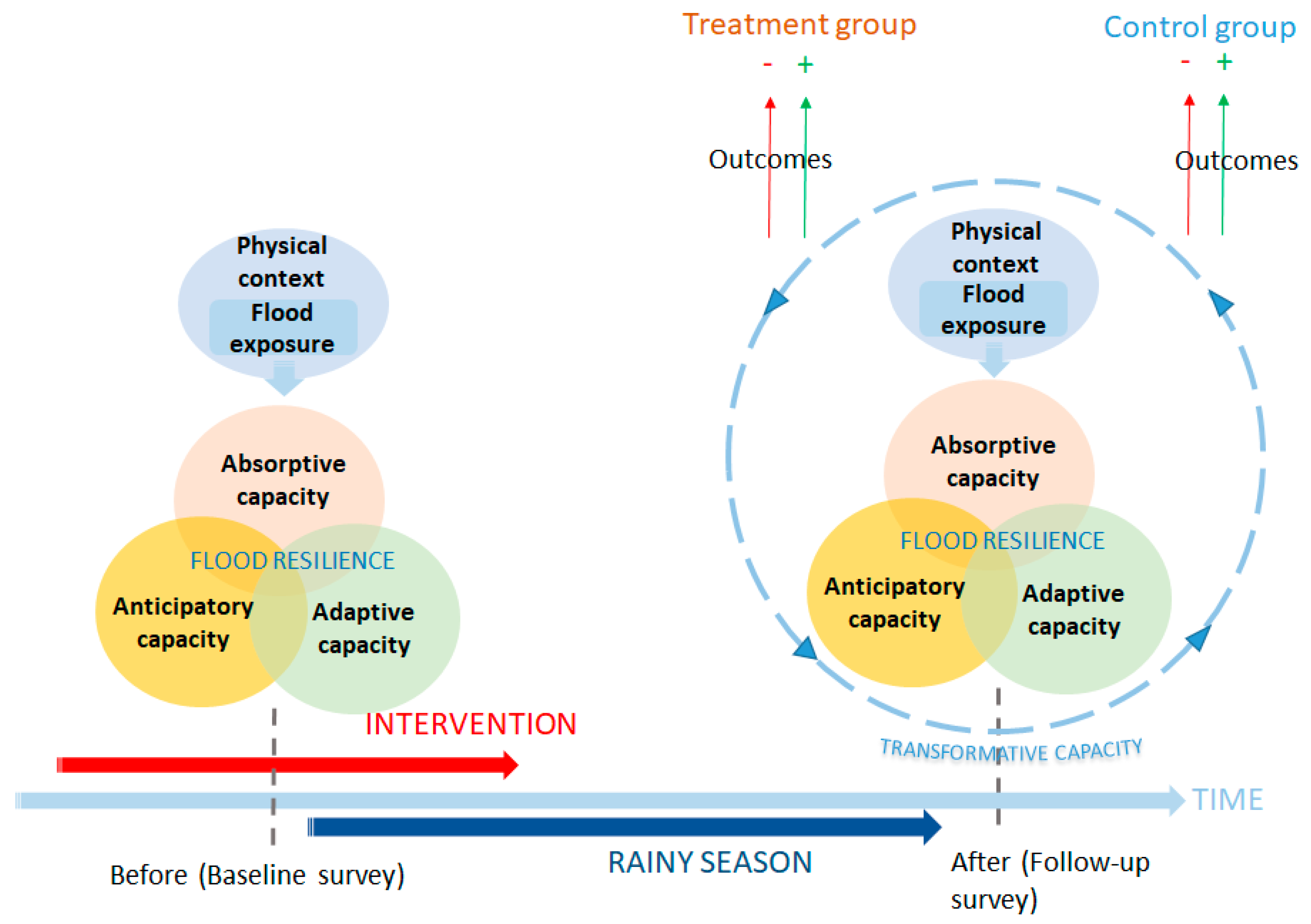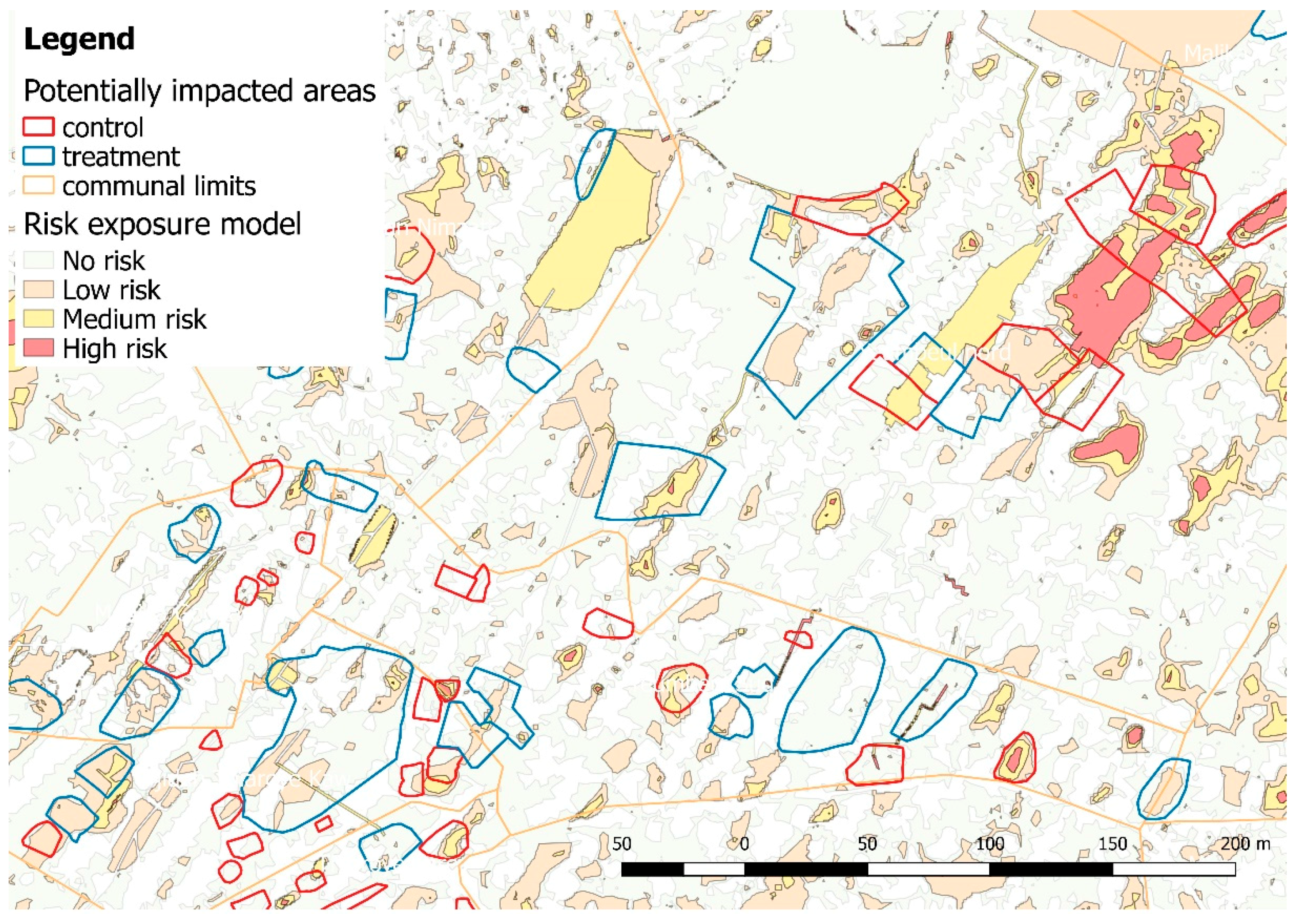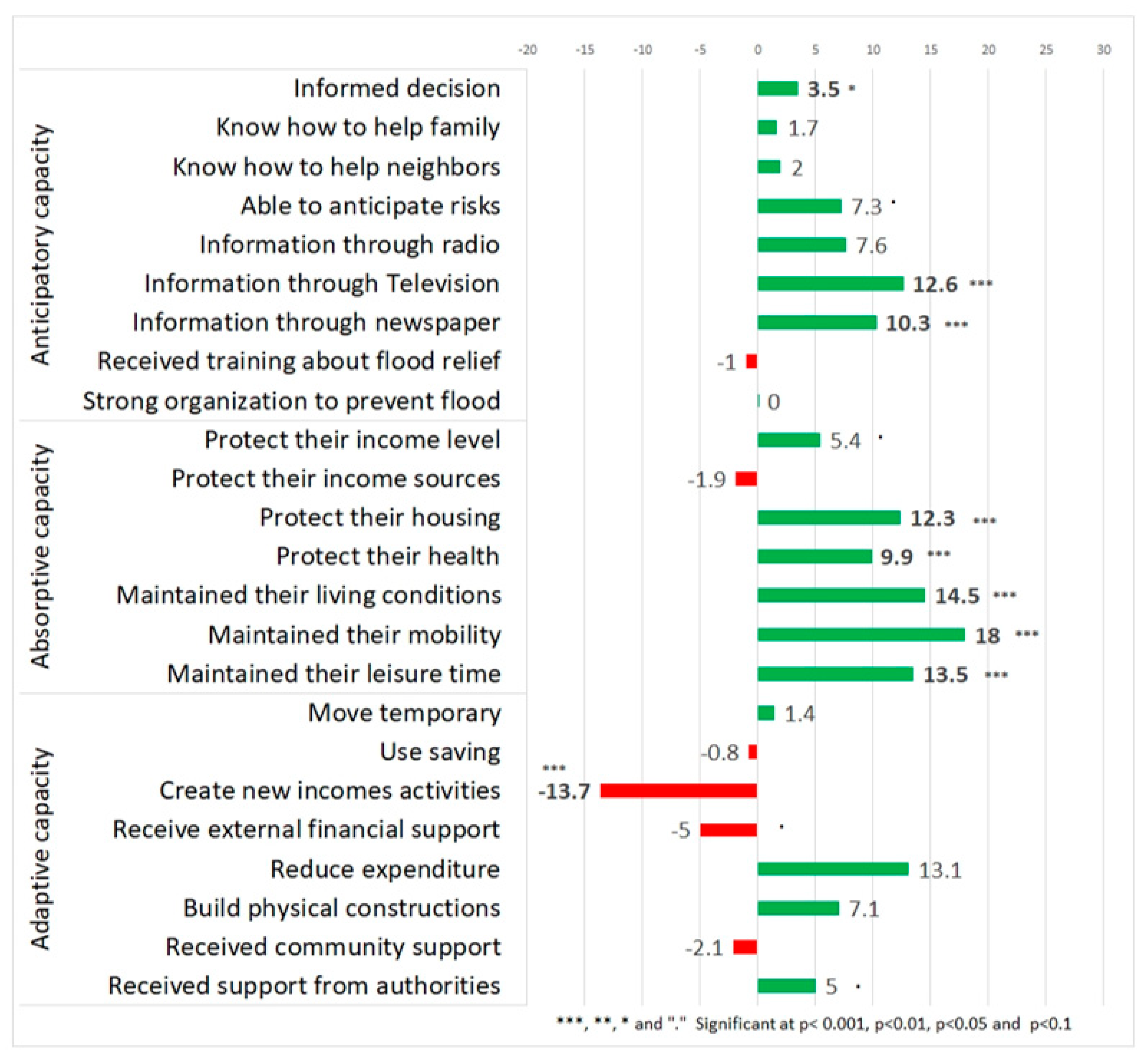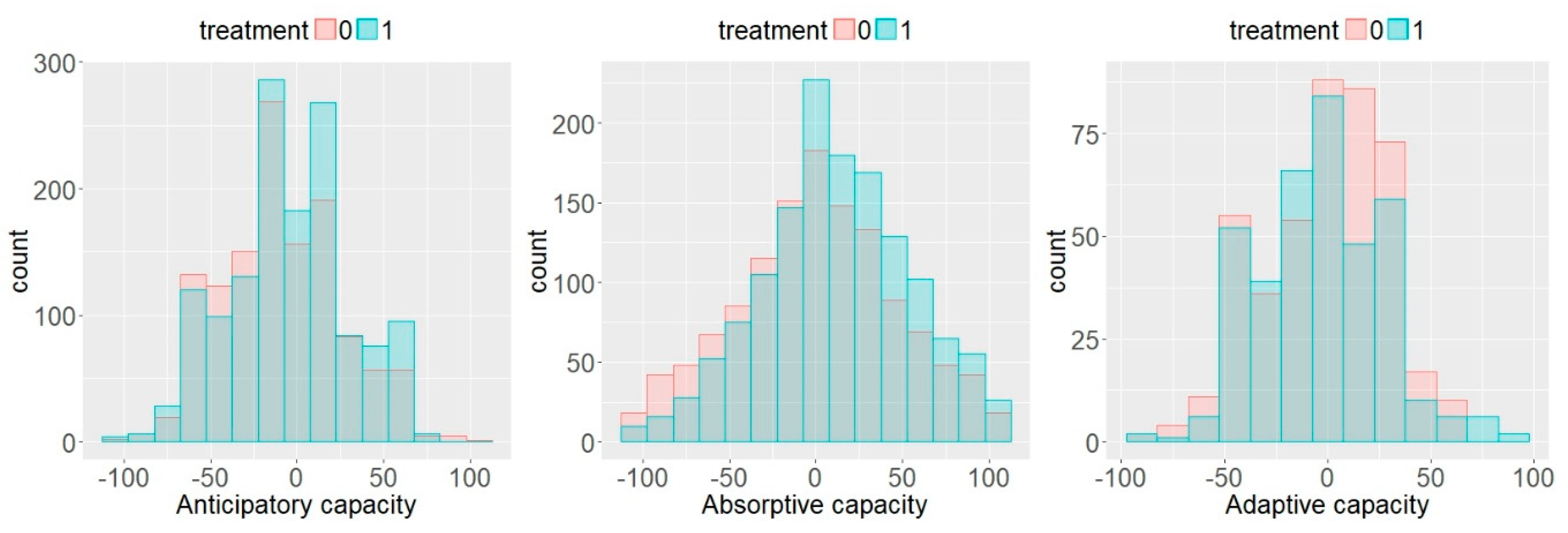Measuring Subjective Flood Resilience in Suburban Dakar: A Before–After Evaluation of the “Live with Water” Project
Abstract
1. Introduction
1.1. The BRACED-Live with Water Project
1.2. Measuring Subjective Social Resilience
2. Materials and Methods
2.1. Measure of Impact
2.2. Data Preparation and Collection
2.2.1. Preparation of the Intervention
2.2.2. Sampling
2.2.3. Survey Data Collection
2.3. Data Analysis: Outcome Indicators of Resilience and ‘Difference-in-Differences’ Estimators in Semi-Experimental Design
2.3.1. The Flood Exposure Index
2.3.2. “3As” Indexes
2.3.3. Difference-in-Differences
3. Results
3.1. Detailed Changes in Households’ Selected Indicators of Subjective Flood Resilience
3.2. Measuring Subjective Flood Resilience Using Each of the “3As” as a Composite Index
4. Discussion
5. Conclusions
Author Contributions
Funding
Acknowledgments
Conflicts of Interest
References
- Barrios, S.; Bertinelli, L.; Strobl, E. Climatic change and rural–urban migration: The case of sub-saharan africa. J. Urban Econ. 2006, 60, 357–371. [Google Scholar] [CrossRef]
- Broekhuis, A.; de Bruijn, M.; de Jong, A. Urban-rural linkages and climatic variability. In The Impact of Climate Change on Drylands; Springer: Berlin, Germany, 2004; pp. 301–321. [Google Scholar]
- Black, R.; Bennett, S.R.; Thomas, S.M.; Beddington, J.R. Climate change: Migration as adaptation. Nature 2011, 478, 447–449. [Google Scholar] [CrossRef] [PubMed]
- Gueye, C.; Fall, A.S.; Tall, S.M. Dakar, touba and the senegalese cities network produced by climate change. Curr. Opin. Environ. Sustain. 2015, 13, 95–102. [Google Scholar] [CrossRef]
- Guha-Sapir, D.; Vos, F.; Below, R.; Penserre, S. Annual Disaster Statistical Review 2011: The Numbers and Trends; UCL: London, UK, 2012. [Google Scholar]
- Diallo, A.; Ndam, N.T.; Moussiliou, A.; Dos Santos, S.; Ndonky, A.; Borderon, M.; Oliveau, S.; Lalou, R.; Le Hesran, J.-Y. Asymptomatic carriage of plasmodium in urban dakar: The risk of malaria should not be underestimated. PLoS ONE 2012, 7, e31100. [Google Scholar] [CrossRef] [PubMed]
- World Health Organization (WHO). Quantitative Risk Assessment of the Effects of Climate Change on Selected Causes of Death, 2030s and 2050s; WHO: Geneva, Switzerland, 2014. [Google Scholar]
- Maheu, A. Urbanization and flood vulnerability in a peri-urban neighbourhood of dakar, senegal: How can participatory gis contribute to flood management? In Climate Change and the Sustainable Use of Water Resources; Springer: Berlin, Germany, 2012; pp. 185–207. [Google Scholar]
- Sané, O.D.; Gaye, A.T.; Diakhaté, M.; Aziadekey, M. Critical factors of vulnerability that enable medina gounass (dakar/senegal) to adapt against seasonal flood events. J. Geogr. Inf. Syst. 2016, 8, 457–469. [Google Scholar] [CrossRef]
- Mbow, C.; Diop, A.; Diaw, A.T.; Niang, C.I. Urban sprawl development and flooding at yeumbeul suburb (dakar-senegal). Afr. J. Environ. Sci. Technol. 2008, 2, 75–88. [Google Scholar]
- Mulligan, J.; Harper, J.; Kipkemboi, P.; Ngobi, B.; Collins, A. Community-Responsive Adaptation to Flooding in Kibera, Kenya. Available online: https://www.icevirtuallibrary.com/doi/10.1680/jensu.15.00060 (accessed on 10 June 2018).
- Dasylva, S. Inondations à Dakar et au Sahel: Gestion Durable des Eaux de Pluie; Enda Éditions: Dakar, Senegal, 2009. [Google Scholar]
- O’Donnell, E.C.; Lamond, J.E.; Thorne, C.R. Learning and action alliance framework to facilitate stakeholder collaboration and social learning in urban flood risk management. Environ. Sci. Policy 2018, 80, 1–8. [Google Scholar] [CrossRef]
- Djalante, R.; Holley, C.; Thomalla, F. Adaptive governance and managing resilience to natural hazards. Int. J. Disaster Risk Sci. 2011, 2, 1–14. [Google Scholar] [CrossRef]
- Alexander, M.; Priest, S.; Mees, H. A framework for evaluating flood risk governance. Environ. Sci. Policy 2016, 64, 38–47. [Google Scholar] [CrossRef]
- Hammond, M.J.; Chen, A.S.; Djordjević, S.; Butler, D.; Mark, O. Urban flood impact assessment: A state-of-the-art review. Urban Water J. 2015, 12, 14–29. [Google Scholar] [CrossRef]
- Carpenter, S.; Walker, B.; Anderies, J.M.; Abel, N. From metaphor to measurement: Resilience of what to what? Ecosystems 2001, 4, 765–781. [Google Scholar] [CrossRef]
- Maclean, K.; Cuthill, M.; Ross, H. Six attributes of social resilience. J. Environ. Plan. Manag. 2014, 57, 144–156. [Google Scholar] [CrossRef]
- Ifejika Speranza, C.; Wiesmann, U.; Rist, S. An indicator framework for assessing livelihood resilience in the context of social–ecological dynamics. Glob. Environ. Chang. 2014, 28, 109–119. [Google Scholar] [CrossRef]
- Béné, C. Towards a quantifiable measure of resilience. IDS Work. Pap. 2013, 2013, 1–27. [Google Scholar] [CrossRef]
- Jacobi, J.; Schneider, M.; Bottazzi, P.; Pillco, M.; Calizaya, P.; Rist, S. Agroecosystem resilience and farmers’ perceptions of climate change impacts in cocoa farms in alto beni, bolivia. Renew. Agric. Food Syst. 2013, 30, 170–183. [Google Scholar] [CrossRef]
- Pelling, M.; Wisner, B. Disaster Risk Reduction: Cases from Urban Africa; Routledge: Abingdon, UK, 2012. [Google Scholar]
- Jones, L.; Tanner, T. Measuring ‘Subjective Resilience’: Using Peoples’ Perceptions to Quantify Household Resilience. Available online: https://www.odi.org/publications/9631-measuring-subjective-resilience-using-peoples-perceptions-quantify-household-resilience (accessed on 10 June 2018).
- Alonso-Tapia, J.; Nieto, C.; Ruíz, M.A. Measuring subjective resilience despite adversity due to family, peers and teachers. Span. J. Psychol. 2013, 16. [Google Scholar] [CrossRef] [PubMed]
- Bahadur, A.V.; Peters, K.; Wilkinson, E.; Pichon, F.; Gray, K.; Tanner, T. The 3as: Tracking Resilience across Braced. Overseas Development Institute (ODI), 2015. Available online: https://www.odi.org/publications/9840-3as-tracking-resilience-acrossbraced (accessed on 10 June 2018).
- Baylis, K.; Honey-Rosés, J.; Börner, J.; Corbera, E.; Ezzine-de-Blas, D.; Ferraro, P.J.; Lapeyre, R.; Persson, U.M.; Pfaff, A.; Wunder, S. Mainstreaming impact evaluation in nature conservation. Conserv. Lett. 2016, 9, 58–64. [Google Scholar] [CrossRef]
- Ferraro, P.J. Counterfactual thinking and impact evaluation in environmental policy. New Dir. Eval. 2009, 2009, 75–84. [Google Scholar] [CrossRef]
- Ferraro, P.J.; Hanauer, M.M. Advances in measuring the environmental and social impacts of environmental programs. Annu. Rev. Environ. Resour. 2014, 39, 495–517. [Google Scholar] [CrossRef]
- Ferraro, P.J.; Pattanayak, S.K. Money for nothing? A call for empirical evaluation of biodiversity conservation investments. PLoS Biol. 2006, 4, e105. [Google Scholar] [CrossRef] [PubMed]
- Gertler, P.J.; Martinez, S.; Premand, P.; Rawlings, L.B.; Vermeersch, C.M.J. Impact Evaluation in Practice; The International Bank for Reconstruction and Development: Washington, DC, USA, 2011. [Google Scholar]
- Pattanayak, S. Rough Guide to Impact Evaluation of Environmental and Development Programs; South Asian Network for Development and Environmental Economics: Kathmandu, Nepal, 2009. [Google Scholar]
- Wooldridge, J.M. Econometric Analysis of Cross Section and Panel Data; MIT Press: Cambridge, MA, USA, 2010. [Google Scholar]
- Pohl, C.; Hadorn, G.H. Principles for Designing Transdisciplinary Research; Oekom: Munich, Germany, 2007. [Google Scholar]
- Underwood, A. On beyond baci: Sampling designs that might reliably detect environmental disturbances. Ecol. Appl. 1994, 4, 3–15. [Google Scholar] [CrossRef]
- Woodhouse, E.; Homewood, K.M.; Beauchamp, E.; Clements, T.; McCabe, J.T.; Wilkie, D.; Milner-Gulland, E.J. Guiding principles for evaluating the impacts of conservation interventions on human well-being. Philos. Trans. R. Soc. B Biol. Sci. 2015, 370. [Google Scholar] [CrossRef] [PubMed]
- Clement, A.R. An application of geographic information system in mapping flood risk zones in a north central city in nigeria. Afr. J. Environ. Sci. Technol. 2013, 7, 365–371. [Google Scholar]
- Coulthard, T.J.; Neal, J.C.; Bates, P.D.; Ramirez, J.; Almeida, G.A.; Hancock, G.R. Integrating the lisflood-fp 2d hydrodynamic model with the caesar model: Implications for modelling landscape evolution. Earth Surface Processes Landf. 2013, 38, 1897–1906. [Google Scholar] [CrossRef]
- Puhani, P.A. The treatment effect, the cross difference, and the interaction term in nonlinear “difference-in-differences” models. Econ. Lett. 2012, 115, 85–87. [Google Scholar] [CrossRef]
- Herk, S.; Zevenbergen, C.; Rijke, J.; Ashley, R. Collaborative research to support transition towards integrating flood risk management in urban development. J. Flood Risk Manag. 2011, 4, 306–317. [Google Scholar] [CrossRef]
- Butler, C.; Pidgeon, N. From ‘flood defence’ to ‘flood risk management’: Exploring governance, responsibility, and blame. Environ. Plan. C Gov. Policy 2011, 29, 533–547. [Google Scholar] [CrossRef]
- Takao, K.; Motoyoshi, T.; Sato, T.; Fukuzondo, T.; Seo, K.; Ikeda, S. Factors determining residents’ preparedness for floods in modern megalopolises: The case of the tokai flood disaster in Japan. J. Risk Res. 2004, 7, 775–787. [Google Scholar] [CrossRef]
- Carmona, A.R. El Proyectorado: Bolivia Tras 20 Años de Ayuda Externa; Intermón Oxfam Editorial: Spain, 2008; Volume 16. [Google Scholar]
- Vedeld, T.; Coly, A.; Ndour, N.M.; Hellevik, S. Climate adaptation at what scale? Multi-level governance, resilience, and coproduction in saint louis, senegal. Nat. Hazards 2016, 82, 173–199. [Google Scholar] [CrossRef]





| Core Concepts of Resilience | Research Definitions | Selected Indicators (SI) |
|---|---|---|
| Anticipatory capacity | The capacity of a social system to anticipate an extreme event or a shock by preparedness, planning, information sharing, and collective action. | 1. Informed decision; 2. know how to help family; 3. know how to help neighbors; 4. capacity to anticipate risk; 5. information through radio; 6. information through TV; 7. information through newspaper; 8. training on flood relief; 9. strong organization to prevent flood event. |
| Absorptive capacity | The capacity to resist from an extreme event or a shock through the mobilization of sufficient resources to create a safety buffer. It can be measured in terms of different capitals (human, social, financial, physical, natural). | 1. Protect income level; 2. protect income sources; 3. protect housing; 4. protect health; 5. maintain living conditions, 6. maintain mobility; 7. maintain leisure time. |
| Adaptive capacity | The capacity to respond adequately to an extreme event or a shock by changing the way the social system is usually functioning and finding alternative solutions. | 1. Move temporary; 2. use savings; 3. create additional income activities; 4. receive external financial support; 5. reduce expenditure; 6. build physical constructions; 7. receive community support; 8. receive support from authorities. |
| Transformative capacity | A time framed dimension of ‘unintended’ or ‘deliberate’ change embracing the first three dimensions (Absorptive, Anticipatory, Adaptive) toward a general improvement of resilience. | Transformative capacity is measured from the combination of absorptive, anticipatory, and adaptive capacities. |
| Baseline (June–July2017) | Follow-up (November–December 2017) | |||||||
|---|---|---|---|---|---|---|---|---|
| Risk Levels | Control | Treat. | Total | %Census | Control | Treat. | Total | %Census |
| High | 68 | 39 | 102 | 87.2 | 60 | 32 | 92 | 78.6 |
| Medium | 359 | 181 | 540 | 89.1 | 334 | 167 | 501 | 82.7 |
| Low | 894 | 1230 | 2124 | 28.5 | 799 | 1101 | 1900 | 25.6 |
| Null | 65 | 80 | 145 | 28.2 | 59 | 73 | 132 | 25.7 |
| Total | 1381 | 1530 | 2911 | 1252 | 1373 | 2625 | ||
| Valid N (Treat.) | Valid N (Contr.) | Intercept 1 | (T-Effect) 2 | Sig. Lev | St. Error | t-Val. | p-Val. | |
|---|---|---|---|---|---|---|---|---|
| FEI | 1386 | 1256 | 26.08 | −4.54 | *** | 1.23 | −3.68 | 0.000 |
| Anticipatory C. | 1386 | 1256 | 35.47 | 4.61 | ** | 1.36 | 3.40 | 0.001 |
| Absorptive C. | 1386 | 1256 | 54.18 | 10.61 | *** | 1.79 | 5.93 | 0.000 |
| Adaptive C. | 381 | 436 | 28.51 | −0.70 | 2.03 | −0.35 | 0.730 |
© 2018 by the authors. Licensee MDPI, Basel, Switzerland. This article is an open access article distributed under the terms and conditions of the Creative Commons Attribution (CC BY) license (http://creativecommons.org/licenses/by/4.0/).
Share and Cite
Bottazzi, P.; Winkler, M.S.; Boillat, S.; Diagne, A.; Maman Chabi Sika, M.; Kpangon, A.; Faye, S.; Speranza, C.I. Measuring Subjective Flood Resilience in Suburban Dakar: A Before–After Evaluation of the “Live with Water” Project. Sustainability 2018, 10, 2135. https://doi.org/10.3390/su10072135
Bottazzi P, Winkler MS, Boillat S, Diagne A, Maman Chabi Sika M, Kpangon A, Faye S, Speranza CI. Measuring Subjective Flood Resilience in Suburban Dakar: A Before–After Evaluation of the “Live with Water” Project. Sustainability. 2018; 10(7):2135. https://doi.org/10.3390/su10072135
Chicago/Turabian StyleBottazzi, Patrick, Mirko S. Winkler, Sébastien Boillat, Abdoulaye Diagne, Mashoudou Maman Chabi Sika, Arsène Kpangon, Salimata Faye, and Chinwe Ifejika Speranza. 2018. "Measuring Subjective Flood Resilience in Suburban Dakar: A Before–After Evaluation of the “Live with Water” Project" Sustainability 10, no. 7: 2135. https://doi.org/10.3390/su10072135
APA StyleBottazzi, P., Winkler, M. S., Boillat, S., Diagne, A., Maman Chabi Sika, M., Kpangon, A., Faye, S., & Speranza, C. I. (2018). Measuring Subjective Flood Resilience in Suburban Dakar: A Before–After Evaluation of the “Live with Water” Project. Sustainability, 10(7), 2135. https://doi.org/10.3390/su10072135







